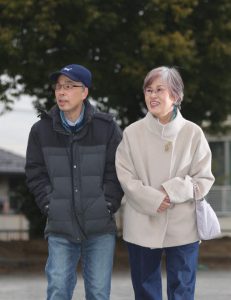Hiroshima Summit—Starting point for abolition of nuclear weapons, Part 6: A-bomb survivor with microcephaly
Feb. 16, 2023
In-utero exposure to A-bomb radiation led to her brother’s suffering
by Michiko Tanaka, Senior Staff Writer
Yoko Nakai, 71, a resident of Yokohama City in Kanagawa Prefecture, lives with her older brother, Shinichi, 77. Shinichi, unable to read, write, or do math, is always calm and kind and liked by everyone. He is an A-bomb survivor with microcephaly (a condition marked by a small head size) who has cognitive and physical impairments from his exposure to high radiation doses from the atomic bombing while in his mother’s womb. Yoko sometimes catches herself thinking about what life would have been like for her brother and family if only the bombing had never happened.
On August 6, 1945, Shinichi was in the womb of his mother, Tomie, who was 25 at the time. His father, Takeo, then 31, had switched jobs, recently moving his family from Osaka to the area of Shinichi-machi (now part of Hiroshima’s Naka Ward). The family included two girls, aged five and three years old. The entire family experienced the atomic bombing while they were at home.
Their house was located just 700 meters from the hypocenter. Takeo suffered serious burns and Tomie had countless shards of glass pierce her body. They both suffered severe aftereffects from the bombing, with both losing all their hair and teeth. The condition of the oldest five-year-old daughter worsened by the day, and in September she died in Himeji City in Hyogo Prefecture, where the family had evacuated.
Decision made to live with brother
The A-bomb radiation also caused damage inside Tomie’s womb. On New Year’s Day in 1946, the year after the bombing, Shinichi was born prematurely. Soon after birth, he was found to have a tumor behind his right eye, resulting in the entire eyeball having to be surgically removed. Even as he grew older, his language skills were not developing normally. He went to elementary school only for the first term of the first grade. His head was smaller than that of other people, and he seems to have been bullied at school. Whenever he went out of the home, either his father or mother always accompanied him.
Ms. Nakai, born six years after the end of the war, looked back on those days. “My parents were devoted in their efforts to protect my brother,” she explained. In her mid-20s, after her engagement to her fiancé was called off due to the presence of her brother, she made up her mind at the depths of her despair to “take care of my brother until the end of his life.” Meanwhile, she refused to listen to their parents’ stories about what they had experienced the day of the bombing or to tell people her brother had been in Hiroshima at that time. She just wanted to turn her back on that dark past.
Around ten years after the end of the war, she and her family moved to Yokohama, far away from Hiroshima. They found themselves in a situation with little understanding among people around them and a scarcity of information about the atomic bombing. In 1965, parents of children with microcephaly facing worries about the future of their children, who had been increasingly isolated from society, established the Kinoko-kai (in English, Mushroom Club) in Hiroshima City. In 1967, they successfully lobbied the national government to recognize that the microcephaly had been caused by the atomic bombing and to grant compensation for such individuals once they were recognized as being A-bomb survivors with microcephaly.
“Have our presence be known by others”
Yoko became aware of the system providing assistance a full 20 years after it had been initiated. In 1989, by the time he was granted recognition as being an A-bomb survivor with microcephaly, Shinichi was already 43 years old. Later, after their parents and second oldest sister died, Yoko and Shinichi found themselves alone. In 2019, they came across the Kinoko-kai organization. Encouraged by the presence of club members who continued to point out the inhumane nature of nuclear weapons, Yoko changed her thinking about the issue. She explained, “I ultimately realized that our mission, my brother and I, is to have our presence be known by others.”
The senior members around the age of their parents’ generation, who once formed the core of the group, are now gone. The group’s membership totaled 25 people at one time, but that number has declined to 12. As the members continued to age, Yoko wrote a letter to government representatives who were attending the First Meeting of States Parties to the Treaty on the Prohibition of Nuclear Weapons (TPNW), held in June last year, on behalf of the club members. “If I could start over, I would not ask for much. I would ask only that my brother get a chance to live in a world with no atomic bombs, no nuclear weapons,” she wrote.
Ms. Nakai hopes to convey the same message to the leaders scheduled to visit Hiroshima later in May this year to participate in the summit meeting of the G7 (Group of Seven industrialized nations). Her letter concluded with the request, “To ensure that people, families, do not have to suffer devastation from nuclear weapons, please make the world a place in which every person can live in safety and security.”
(Originally published on February 16, 2023)








